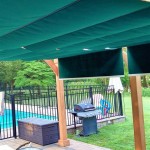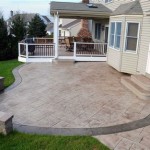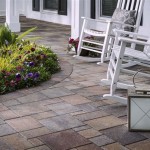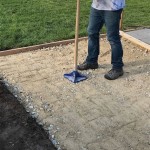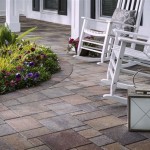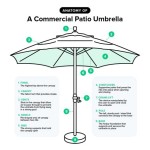How To Clean Concrete Patio With a Power Washer
A concrete patio offers a durable and versatile outdoor space, ideal for relaxation, entertaining, and enjoying the open air. However, exposure to the elements inevitably leads to the accumulation of dirt, grime, algae, mildew, and other unsightly stains. Maintaining a clean concrete patio not only enhances its aesthetic appeal but also prolongs its lifespan by preventing the gradual degradation caused by these contaminants. A power washer, also known as a pressure washer, provides a highly effective method for removing these stubborn substances and restoring the patio's original appearance. This article details the steps involved in cleaning a concrete patio using a power washer, emphasizing safety precautions and best practices to achieve optimal results.
Prior to initiating the cleaning process, proper preparation is essential. This involves gathering the necessary equipment, assessing the condition of the concrete, and taking steps to protect surrounding areas. The selection of appropriate cleaning agents is also crucial for tackling specific types of stains and contamination.
Preparing for Power Washing
The first step in preparing for power washing is to gather the required equipment. This includes the power washer itself, a suitable nozzle, a garden hose for water supply, safety glasses, gloves, and appropriate footwear. Depending on the specific cleaning needs, additional items such as a surface cleaner attachment, a cleaning solution applicator, and a stiff-bristled brush may be beneficial.
The power washer should be selected based on the size and condition of the patio. For smaller patios with light to moderate staining, an electric power washer with a pressure rating of 1500-2000 PSI (pounds per square inch) may suffice. Larger patios or those with heavy soiling may require a gasoline-powered model with a higher PSI rating, typically in the range of 2500-3000 PSI or more. It is crucial to consult the manufacturer's instructions for the specific power washer model to ensure safe and effective operation.
Nozzle selection is also important. A wide-angle nozzle, such as a 25-degree or 40-degree nozzle, is suitable for general cleaning and preventing damage to the concrete surface. A more concentrated nozzle, such as a 15-degree or 0-degree nozzle, may be used for stubborn stains but requires caution to avoid etching or scarring the concrete. Turbo nozzles, also known as rotary nozzles, provide a rotating spray pattern that can be effective for removing heavily embedded dirt.
Safety is paramount when operating a power washer. Safety glasses are essential to protect the eyes from flying debris, and gloves should be worn to protect the hands from the high-pressure spray and cleaning solutions. Closed-toe shoes or boots are necessary to prevent foot injuries. It's also vital to ensure that no children or pets are present in the work area during the cleaning process.
Before commencing the power washing, it is advisable to clear the patio of all furniture, planters, and other movable objects. Sweep or remove any loose debris, such as leaves, twigs, and dirt, using a broom or leaf blower. This will prevent these materials from being washed into drains or causing obstructions.
Protecting surrounding areas is also a key consideration. If there are nearby plants, shrubs, or other delicate landscaping features, they should be covered with plastic sheeting or tarps to prevent damage from the high-pressure spray or cleaning solutions. Similarly, windows, doors, and siding should be protected to avoid water intrusion or discoloration. It may also be necessary to redirect runoff water to prevent flooding or erosion in adjacent areas.
Before applying any cleaning solutions, it's important to assess the condition of the concrete patio. Check for cracks, chips, or other signs of damage. Power washing damaged concrete can exacerbate these issues, so it may be necessary to make repairs before proceeding. Also, identify any specific types of stains, such as oil, grease, rust, or mildew, as different cleaning solutions may be required to address them effectively.
The selection of appropriate cleaning agents is contingent upon the type and severity of the staining. For general cleaning, a mild detergent or a specialized concrete cleaner can be used. For oil and grease stains, a degreaser specifically formulated for concrete is recommended. Rust stains may require a rust remover containing oxalic acid or citric acid. Mildew and algae can be treated with a solution of diluted bleach or a commercial mildew remover. It is imperative to follow the manufacturer's instructions carefully when using any cleaning solutions and to test them in an inconspicuous area first to ensure they do not damage or discolor the concrete.
The Power Washing Process
Once the preparation is complete, the power washing process can begin. The initial step involves pre-soaking the concrete surface with water. This helps to loosen dirt and grime, making it easier to remove with the power washer. Using the garden hose, thoroughly wet the entire patio area. Avoid pooling water, as this can interfere with the cleaning process.
Next, apply the chosen cleaning solution, if applicable. Depending on the product, this may involve mixing the solution with water in a bucket or using a cleaning solution applicator attached to the power washer. Follow the manufacturer's instructions for the correct dilution ratio and application method. Apply the solution evenly over the entire patio surface, ensuring that all areas are thoroughly covered. Allow the solution to dwell on the concrete for the recommended amount of time, typically 5-10 minutes, to allow it to penetrate and loosen the stains.
After the dwell time, begin power washing the concrete patio. Start with a low-pressure setting and a wide-angle nozzle to avoid damaging the surface. Hold the nozzle at a distance of approximately 12-18 inches from the concrete and use a sweeping motion to clean the entire area. Overlap each pass slightly to ensure that no areas are missed. Work in small sections, gradually increasing the pressure as needed to remove stubborn stains.
For particularly challenging stains, a more concentrated nozzle or a surface cleaner attachment may be used. A surface cleaner attachment is a circular device with rotating nozzles that provides a more consistent and even cleaning pattern. It is particularly useful for large patio areas. When using a more concentrated nozzle, exercise caution to avoid etching or scarring the concrete. Keep the nozzle moving and avoid holding it in one spot for too long.
As the patio is cleaned, periodically rinse the area with clean water to remove the dislodged dirt and cleaning solution. This will help to prevent the solution from drying on the concrete and leaving behind residue. Inspect the cleaned area carefully to ensure that all stains and contaminants have been removed. If necessary, repeat the cleaning process on any remaining stubborn stains.
After the entire patio has been power washed, perform a final rinse with clean water to remove any remaining traces of cleaning solution. Ensure that all runoff water drains properly and does not accumulate in low-lying areas. Allow the patio to dry completely before replacing furniture and other objects.
Post-Cleaning Maintenance and Precautions
Once the concrete patio has been power washed, there are several steps that can be taken to maintain its cleanliness and prolong its lifespan. One of the most effective measures is to apply a concrete sealer. A concrete sealer is a protective coating that helps to prevent water penetration, which can lead to cracking and spalling. It also helps to resist staining and makes the patio easier to clean in the future. Choose a sealer that is appropriate for the type of concrete and the intended use of the patio. Follow the manufacturer's instructions for application, which typically involves cleaning the patio thoroughly and then applying the sealer with a roller or sprayer.
Regular sweeping and cleaning can also help to maintain the cleanliness of the patio. Sweep the patio regularly to remove loose debris, such as leaves, twigs, and dirt. Periodically wash the patio with a mild detergent and water to remove surface stains and grime. Avoid using harsh chemicals or abrasive cleaners, as these can damage the concrete surface.
Addressing spills promptly is crucial to prevent staining. If spills occur, such as oil, grease, or wine, clean them up immediately with a absorbent cloth or paper towels. For stubborn spills, use a specialized stain remover specifically formulated for concrete. Follow the manufacturer's instructions carefully. Some spills, such as acid, might require neutralizing the affected area before cleaning.
Preventative measures can significantly reduce the need for frequent power washing. Using mats and rugs in high-traffic areas can help to protect the concrete from wear and tear. Placing drip trays under potted plants can prevent stains from soil and fertilizer runoff. Trimming back overhanging trees and shrubs can reduce the amount of leaves and debris that accumulate on the patio. Ensuring proper drainage can prevent water from pooling and causing damage to the concrete.
During winter months, take precautions to protect the concrete patio from freeze-thaw damage. Remove snow and ice promptly to prevent water from seeping into cracks and expanding when it freezes. Avoid using salt or other de-icing chemicals, as these can damage the concrete surface. Instead, use sand or gravel to provide traction. Consider covering the patio with a tarp or plastic sheeting to protect it from the elements.
Power washing can be a very effective way to clean concrete patios, but it is important to take precautions to avoid damaging the surface. Always start with a low-pressure setting and a wide-angle nozzle. Avoid using excessive pressure, as this can etch or scar the concrete. Keep the nozzle moving and avoid holding it in one spot for too long. If using cleaning solutions, follow the manufacturer's instructions carefully and test them in an inconspicuous area first. Wear appropriate safety gear, including safety glasses, gloves, and closed-toe shoes. By following these guidelines, the concrete patio can be cleaned safely and effectively, restoring it to its original beauty and extending its lifespan.

Best Way To Clean A Concrete Patio Chalking Up Success

How To Pressure Wash Concrete Driveways Patios Network

How To Re Your Concrete Patio With Power Washing Wiseguys Pro Wash

How To Clean Concrete The Easy Way Porches Patios Driveways More Run Radiance

How To Clean Patio Slabs Minster Paving

How To Clean A Concrete Patio Maintenance Tips Network

Diy Miracle Concrete Patio Cleaner I Should Be Mopping The Floor

How To Clean Concrete Professional Pressure Washing Vs Diy Washh

How To Clean A Concrete Patio Fast

Power Washing Concrete Patio Revive
Related Posts


